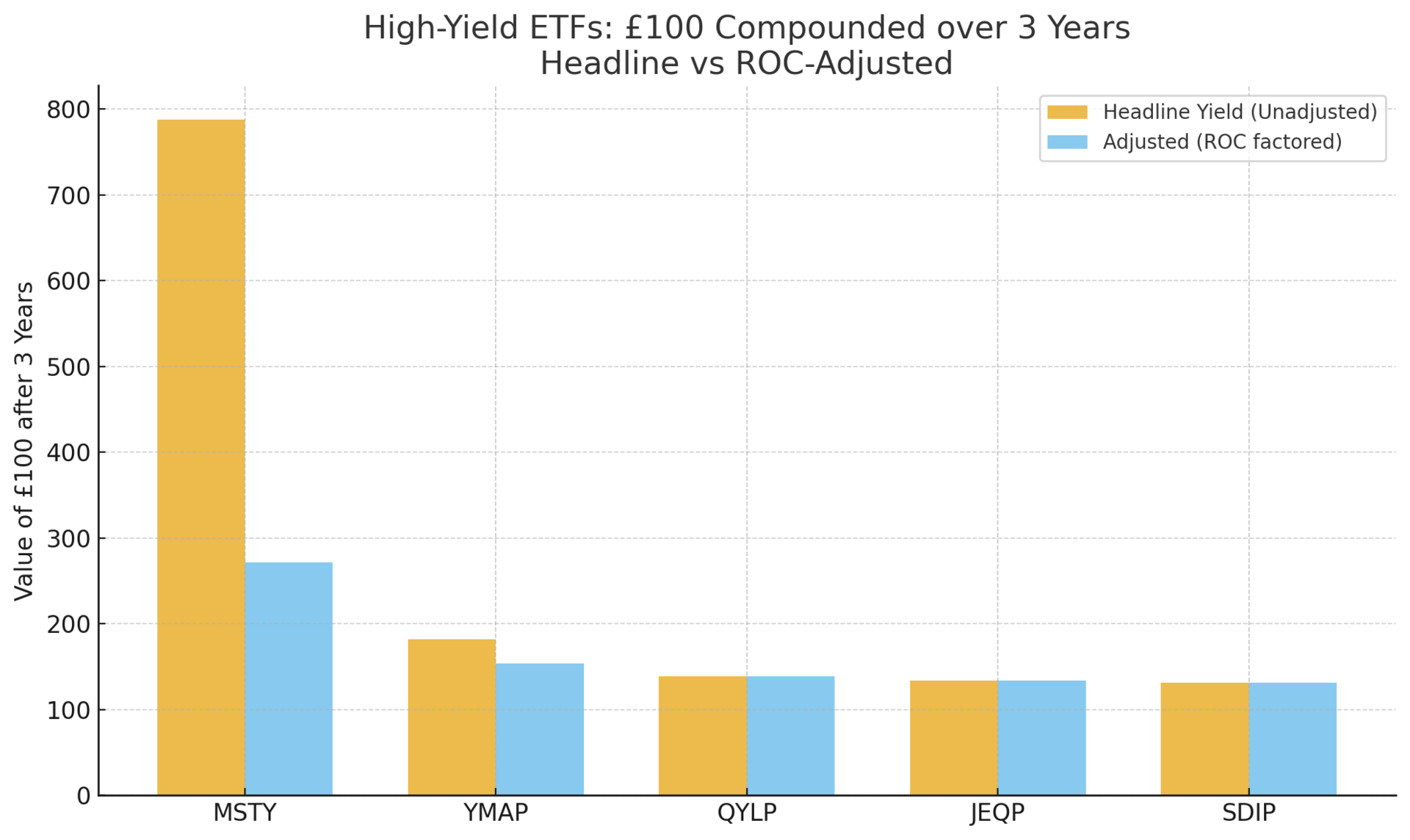- Portfolio Parrot 💸
- Posts
- High-Yield UK ETFs in 2025: Income Opportunity or Illusion?
High-Yield UK ETFs in 2025: Income Opportunity or Illusion?
High-yield ETFs promise double-digit payouts, but how much is real income versus return of capital? We break down five popular funds for UK investors.
The Rise of High-Yield ETFs
In 2025, more investors are drawn to ETFs offering eye-catching double-digit yields. These often use covered-call strategies or focus on high-dividend stocks. For UK investors, funds like £JEQP and MSTY have become popular choices.
The question is: how sustainable are these yields, and what role can they play in a balanced portfolio?
I’ll break down five ETFs: £JEQP, MSTY, £SDIP, £YMAP, and £QYLP and simulate what a £100 investment might look like after three years.
My Current Holdings
£JEQP – JPMorgan Nasdaq Equity Premium Income UCITS
Tracks the Nasdaq-100, selling out-of-the-money covered calls.
Yield: ~10.75% | Fees: 0.35% | YTD return (mid-Sep 2025): +12.47%
Efficient, UCITS-compliant, and relatively stable.
MSTY – YieldMax MSTR Option Income
Linked to MicroStrategy, often seen as a Bitcoin proxy.
Trailing yield: up to 179.88%, but 60.65% of payouts in Aug 2025 were return of capital (ROC).
YTD return: +13.03% | High volatility, not tax-efficient for UK investors.
Together, these provide a mix of steady option income (JEQP) and speculative, crypto-linked payouts (MSTY).
New Options to Explore
£SDIP – Global Dividend Stability
Strategy: 100 high-yield global stocks (REITs, utilities, financials).
Yield: ~10.22% | Fees: 0.45% | YTD return: +9.23%
Pros: Diversified, real dividends.
Cons: Exposed to dividend cuts and currency risk.
£YMAP – Big Tech Covered Calls
Strategy: Covered calls on AAPL, MSFT, NVDA, AMZN, META, GOOGL.
Yield: ~23%, but part ROC | Fees: 0.99% | YTD return: +8.00%
Pros: High payouts, tech exposure.
Cons: High fees, capped upside, ROC risk.
£QYLP – Nasdaq Covered Call UCITS
Strategy: At-the-money calls on Nasdaq-100.
Yield: ~13% | Fees: 0.45% | YTD return: –12.91%
Pros: Higher yield than JEQP, established track record.
Cons: More upside capped, counterparty risk.
£100 Over 3 Years: The Simulation

High-Yield ETFs: £100 Compounded over 3 Years Headline vs ROC-Adjusted
If you reinvest everything based on headline yields:
Fund | £100 → 3 Years |
|---|---|
MSTY | £788 |
YMAP | £182 |
QYLP | £139 |
£JEQP | £134 |
£SDIP | £131 |
But after adjusting for return of capital (ROC):
Fund | £100 → 3 Years (Adjusted) |
|---|---|
MSTY | £272 |
YMAP | £154 |
QYLP | £139 |
£JEQP | £134 |
£SDIP | £131 |
The apparent 100%+ yields shrink once ROC is stripped out.
Key Takeaways
Diversification: JEQP and SDIP provide a steadier base; MSTY and YMAP are more speculative.
ROC Matters: ROC distributions reduce NAV, inflating yield figures.
Fees Count: JEQP, SDIP, QYLP (0.35–0.45%) vs. MSTY, YMAP (~0.99%).
Tax Positioning: UCITS ETFs are generally more efficient for UK investors than US-listed MSTY.
Market Conditions: Covered-call strategies perform best in sideways or volatile markets, not during strong rallies.
Final Thoughts
For 9–5 investors, high yields are tempting. But what looks like a 20%+ payout often includes return of capital rather than sustainable income.
Anchor with JEQP or SDIP for stability.
Use QYLP tactically for enhanced Nasdaq exposure.
Treat MSTY and YMAP as speculative, not core holdings.
High-yield ETFs can play a role in an income strategy, but the difference between genuine dividends and return of capital is what really defines the outcome.
Disclaimer: This article is for informational and research purposes only and does not constitute investment advice. Always conduct your own research or speak to a qualified professional before investing.
Markets move fast. Savvy investors spot trends early.
Every Monday, get my pre-market cheat sheet:
✅ What’s hot
✅ What’s fading
✅ Where smart money’s flowing
No hype—just data.
👉 Subscribe to stay ahead.
Reply